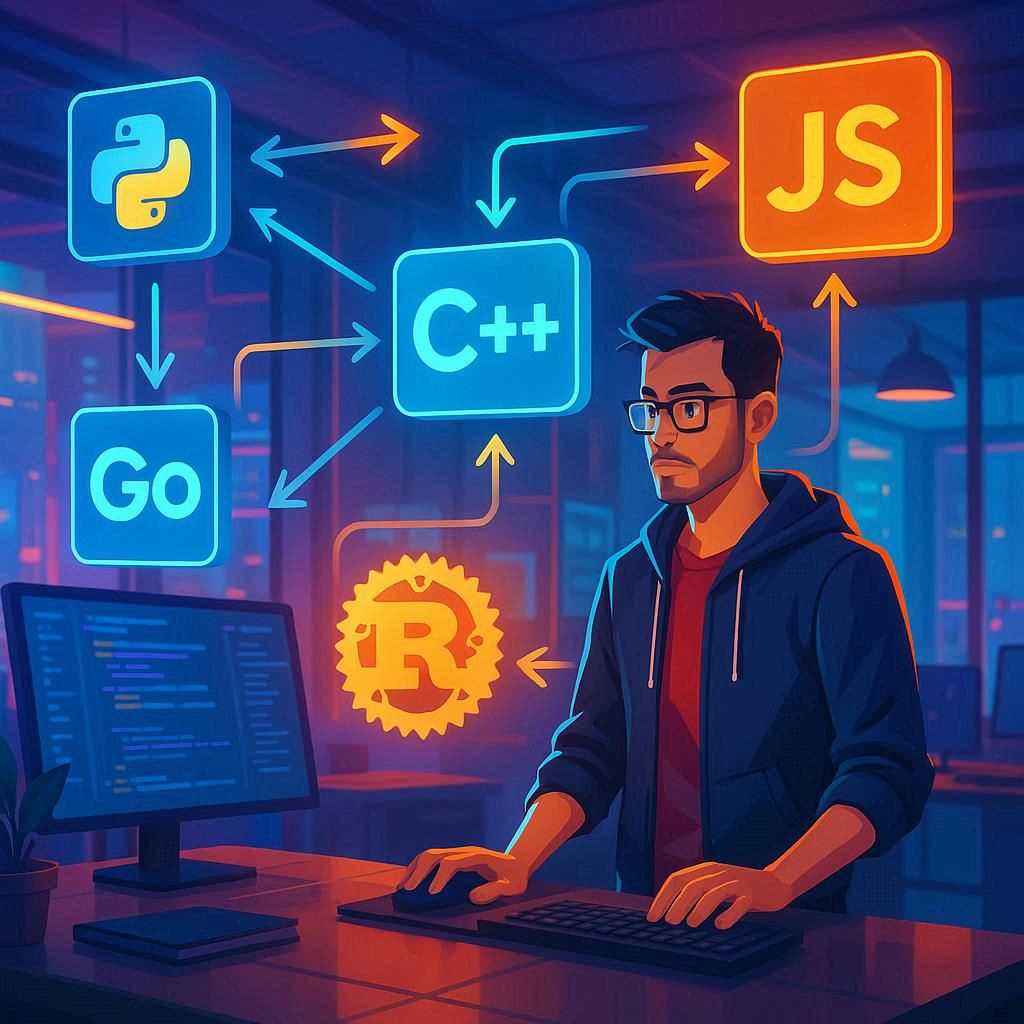
The Rise of Polyglot Programmers (And How You Can Become One in 2025)
Table of Contents
Introduction – The New Breed of Developers
In the fast-changing world of software development, sticking to one language for your entire career is becoming a rare choice. Developers are increasingly expected to work across multiple stacks, adapt to new trends, and pick up new skills quickly. This shift has given rise to a new breed of professionals — the polyglot programmers. These are developers who can code fluently in multiple languages and understand how to integrate different technologies into a single, cohesive solution.
The benefits of being a polyglot programmer go beyond just writing code in different syntaxes. It’s about developing a problem-solving mindset that allows you to choose the right tool for the right job, rather than forcing one language or framework to do everything. In a world where innovation often comes from combining diverse tools and approaches, the polyglot programmer holds a distinct advantage.
But this rise hasn’t come out of nowhere. It’s a response to how tech companies, startups, and open-source communities operate today. The demand for versatility is driven by the need to quickly pivot, experiment, and innovate. As we’ll explore in this article, becoming a polyglot programmer is not just about learning a list of languages — it’s about cultivating a mindset and workflow that makes you adaptable and valuable.

Why Polyglot Programmers Are in Demand
In today’s rapidly evolving tech landscape, companies are no longer satisfied with developers who only excel in a single programming language. While specialization still has its place, businesses are realizing that projects are rarely confined to one technology stack. A web app might have a JavaScript-based frontend, a Python-powered backend, and a database optimized with SQL or NoSQL queries. Having a team member who can navigate across these environments not only reduces dependency on multiple specialists but also speeds up problem-solving. This versatility is particularly valued in startups and agile teams, where quick adaptation is a survival skill.
Another driving factor behind the rise in demand for polyglot programmers is the increasing complexity of integrated systems. APIs, microservices, cloud deployments, and cross-platform applications require knowledge of multiple languages to ensure smooth communication between different components. A developer who can bridge these gaps becomes an invaluable asset, capable of ensuring interoperability without having to wait on other departments or external contractors. This can lead to more cohesive and maintainable codebases, where decision-making is guided by the best tool for the job rather than sticking to a “one-size-fits-all” approach.
On top of this, the shift towards AI, machine learning, and data-driven decision-making has made it essential for developers to expand their skill sets. For example, a polyglot programmer might work in Python for data science tasks, switch to C++ for performance-critical modules, and then integrate the solution into a Node.js environment for web deployment. Employers know that hiring someone with such flexibility means less bottleneck risk and more innovation potential. As technology trends shift, these adaptable professionals can pivot without requiring an entirely new recruitment process.

We have prepared a detailed pdf for Capable ones. So, give it a read
Benefits of Being a Polyglot Programmer
Becoming a polyglot programmer isn’t just about collecting languages like trophies — it’s about unlocking a level of flexibility and problem-solving power that single-language developers might struggle to achieve. One of the biggest benefits is adaptability. When you know multiple programming languages, you can quickly pivot between them to suit the task at hand. If performance is critical, you might turn to C++ or Rust. If you need rapid development for a web app, JavaScript or Python could be your go-to. This flexibility ensures you’re never boxed in by a single tool’s limitations.
Another significant benefit is the ability to choose the best tool for the job rather than forcing every problem into the constraints of one language. A polyglot programmer can approach a project holistically — understanding that a microservices architecture might benefit from Go in one service, Node.js in another, and perhaps even a sprinkle of Python for data analytics. This approach doesn’t just improve efficiency; it leads to more scalable, maintainable systems in the long run.
From a career perspective, polyglot programmers tend to be more valuable to employers and clients. They can contribute across multiple areas of a tech stack, reducing dependency on multiple hires. In startups, where agility is essential, such a skill set can be the difference between a successful launch and a missed opportunity. And in larger enterprises, being able to communicate effectively with different teams working in different languages makes you a natural bridge between silos — a quality that often leads to leadership opportunities.

Key Skills Every Polyglot Programmer Needs
Becoming a polyglot programmer isn’t just about learning multiple programming languages—it’s about mastering the mental agility and practical skills to switch between them seamlessly. A true polyglot understands that every language has its own paradigm, strengths, weaknesses, and community best practices. This means you must develop a mindset that’s adaptable, curious, and willing to unlearn old habits when picking up something new. Without this mental flexibility, even a skilled developer can find themselves trapped in “language bias,” applying the wrong patterns to the wrong context.
The first skill you’ll need is deep problem-solving ability that transcends syntax. In other words, you should be able to approach a problem from a conceptual standpoint before deciding which language fits best. A polyglot doesn’t just think in Java or Python—they think in terms of algorithms, design patterns, and performance constraints. This abstract thinking allows you to adapt to any programming environment, from a low-level systems language like Rust to a high-level scripting language like Ruby.
Another crucial skill is strong debugging capability across different ecosystems. Every language has its own quirks when it comes to debugging, whether it’s Python’s stack traces, Java’s verbose exceptions, or JavaScript’s browser console outputs. Being comfortable navigating these tools means you can jump into any codebase, troubleshoot issues efficiently, and deliver results without being slowed down by unfamiliar error messages. Over time, this skill compounds, making you a valuable “go-to” developer who can resolve cross-language integration issues that others avoid.
Challenges in Becoming a Polyglot Programmer and How to Overcome Them
While the idea of mastering multiple programming languages is exciting, the journey comes with significant challenges that even experienced developers face. One of the biggest hurdles is information overload. Each language comes with its own syntax, libraries, frameworks, and idiomatic practices. Trying to learn too many at once can be overwhelming, causing confusion and slowing your progress. To overcome this, a polyglot programmer must prioritize depth over breadth, focusing on mastering one language at a time while gradually exploring others.
Another challenge is maintaining proficiency across languages. It’s easy to fall out of practice with a language you don’t use daily, which can lead to mistakes and slower coding when switching contexts. A good strategy is to work on small, meaningful projects in each language regularly. For example, writing scripts to automate tasks, contributing to open-source projects, or building microservices in different languages can reinforce your knowledge and keep your skills sharp.
Useful Links
- Software Development Life Cycle (SDLC) in 2025: Stages, Models, and Modern Practices
- The Rise of Composable Software: Why Developers Need to Think Modular in 2025
- Toil is Back: Why Even with AI, SREs Feel the Burn in 2025
- Best Python Libraries for Automation Developers Overlook in 2025
- Functional Programming in 2025: Are Pure Functions Making a Comeback?
- Why Zig Could Be the Next Big Language for Systems Programming in 2025
Finally, there’s the difficulty of bridging paradigms. Many polyglot programmers struggle when moving between languages with vastly different approaches—say, from functional programming in Haskell to object-oriented programming in Java. To overcome this, focus on underlying programming concepts, such as data structures, algorithms, and design patterns, rather than memorizing language-specific syntax. By understanding the “why” behind the code, you can more easily adapt to different paradigms and leverage the best features of each language.

The Future of Polyglot Programming and Why It Matters
As technology continues to evolve at a breakneck pace, the role of polyglot programmers is becoming increasingly critical. Modern software ecosystems are diverse, often combining legacy systems, cloud platforms, microservices, and cutting-edge AI technologies. Developers who can fluently switch between languages like Python, JavaScript, Rust, and Go can bridge these diverse environments and deliver solutions faster. Their versatility allows companies to adopt the best tool for each task rather than being locked into a single technology stack.
The rise of AI-assisted development is also influencing the polyglot trend. Tools like GitHub Copilot, ChatGPT, and other AI coding assistants support multiple programming languages and frameworks. This means developers can experiment, prototype, and deploy in unfamiliar languages without starting from scratch. Polyglot programmers can leverage AI to accelerate learning and productivity, making it easier to handle multi-language projects while maintaining high-quality standards.
Moreover, the growing trend of cross-platform development reinforces the importance of polyglot skills. Mobile apps, web apps, desktop applications, and embedded systems often require knowledge of different languages, libraries, and runtime environments. Developers who can navigate this complexity are not only more employable but also capable of designing holistic, integrated solutions that work seamlessly across platforms. As technology diversifies, the ability to move fluidly between languages will become a key differentiator for successful software engineers.
Conclusion
The journey of polyglot programming is more than just learning multiple languages—it’s about cultivating adaptability, problem-solving skills, and technological intuition. As software ecosystems become increasingly diverse, developers who embrace multiple languages can navigate complex projects, collaborate across platforms, and remain competitive in a fast-evolving industry. The future belongs to those who aren’t confined by a single language or framework but can fluidly move between them to solve problems efficiently.
AI-assisted development, cross-platform requirements, and the proliferation of new programming paradigms will continue to push the demand for polyglot programmers. By investing time in learning diverse languages, understanding when and where to apply them, and leveraging AI as a productivity enhancer, developers can stay ahead of the curve.
Whether you are an aspiring developer or a seasoned professional, now is the time to embrace polyglot programming. Start experimenting, expand your skillset, and collaborate with others to unlock new opportunities in the ever-evolving world of technology. The ability to adapt, learn, and integrate multiple languages may well define the next generation of top-tier software engineers.
FAQS
1. What is a polyglot programmer?
A polyglot programmer is a software developer proficient in multiple programming languages, capable of choosing the most effective language or tool for a given task.
2. Why is polyglot programming important today?
Modern software systems are diverse, including web apps, mobile apps, cloud services, and AI models. Being proficient in multiple languages allows developers to build more adaptable and efficient solutions.
3. How can AI help polyglot programmers?
AI coding assistants like GitHub Copilot and ChatGPT support multiple programming languages, providing real-time suggestions, code generation, and learning assistance, enabling developers to handle projects in languages they are less familiar with.
4. Which languages should I learn first as a polyglot programmer?
Start with languages that complement your current expertise. Popular choices include Python, JavaScript, Java, Go, and Rust, but the best choice depends on your domain and career goals.
5. Is polyglot programming suitable for beginners?
Yes, but beginners should first master one language before branching out. Once foundational concepts are strong, learning additional languages becomes easier, and the benefits of polyglot skills grow exponentially.

🚀 Let's Build Something Amazing Together
Hi, I'm Abdul Rehman Khan, founder of Dev Tech Insights & Dark Tech Insights. I specialize in turning ideas into fast, scalable, and modern web solutions. From startups to enterprises, I've helped teams launch products that grow.
- ⚡ Frontend Development (HTML, CSS, JavaScript)
- 📱 MVP Development (from idea to launch)
- 📱 Mobile & Web Apps (React, Next.js, Node.js)
- 📊 Streamlit Dashboards & AI Tools
- 🔍 SEO & Web Performance Optimization
- 🛠️ Custom WordPress & Plugin Development







